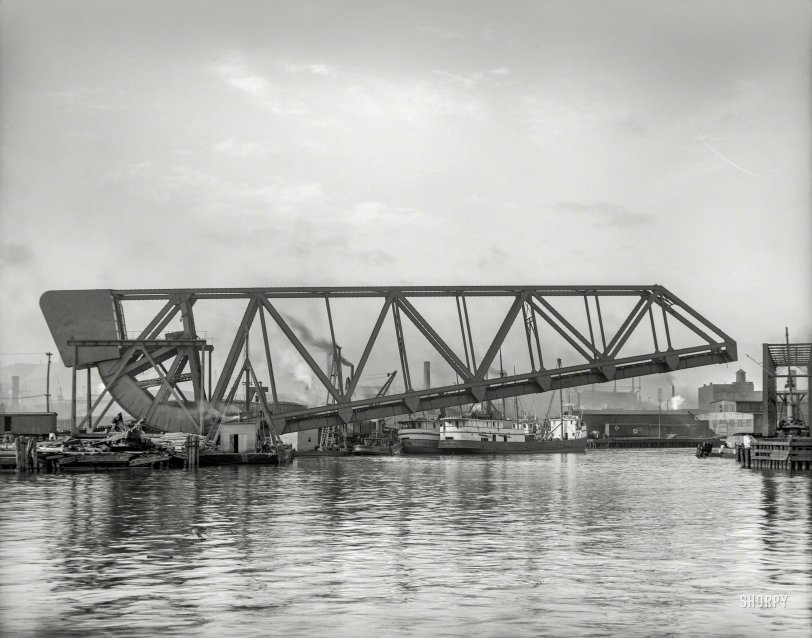


Framed or unframed, desk size to sofa size, printed by us in Arizona and Alabama since 2007. Explore now.
Shorpy is funded by you. Patreon contributors get an ad-free experience.
Learn more.

- Lofty addition
- In 1912
- Keenan Building
- Six years old
- Taken from the P.J. McArdle Roadway?
- It stood only 47 years
- Three track mind
- Incline to the right
- Reach for the sky, 1912 style
- No clean sweep
- Same Job Title, Same Face
- Sadly Lost
- Beautiful ...
- Where you get your kicks
- Aim High
- Pueblo Revival sisters
- Pueblo Neoclassicism
- Milk Man
- Regional dialect.
- Spielberg's inspiration
- Great Photo
- Loaf Story
- Do you still have the Rakes category?
- Could almost be a scene from the 1957 movie 'Hell Drivers'
- The Wages of Fear.
- Conspicuous by their absence
- Got Milk?
- All that aluminum
- No lefties
- Smoke 'em if you've got 'em
Print Emporium
Cuyahoga Lift Bridge: 1910

Cleveland circa 1910. "Lift Bridge, Cuyahoga River." 8x10 inch dry plate glass negative, Detroit Publishing Company. View full size.
No such thing as a dumb question?
Would there be a right half of this bridge out of the frame, presumably already elevated when this picture was taken? How close do the segments of track have to come together to be a functional railroad bridge? Is it (was it) fairly precise and repeatable?
A Scherzer is a type of Bascule
A "rolling lift" bridge, sometimes called a Scherzer, is one of three distinct types of bascule bridge. Check it out on Wikipedia.
Now Who Do We Believe?
Well. When I first saw this image the term bascule bridge popped into mind. But I am no expert on bridges. After seeing Willam Lafferty's and signalman's posts, I was a bit confused. So I turned to our famous online encyclopedia. The term is defined there as "a moveable bridge with a counterweight that continuously balances a span, or 'leaf', throughout its upward swing to provide clearance for boat traffic. It may be single- or double-leafed." At the bottom of the page the single leaf rolling lift type bridge is one of the illustrations. If you want to take a look for yourself, and decide what kind of bridge this is, go to https://en.wikipedia.org/wiki/Bascule_bridge.
Not Bascule
This is a Scherzer rolling lift bridge. The large circular arc segment is the support, and the bridge rolls on that arc as the bridge opens. The drive is at the center of the arc; a motor drives a small gear which rolls on the straight bar above the track level.
This is a Scherzer Rolling Lift Bridge
known as Baltimore & Ohio Bridge No. 464, built in 1907, which I believe still survives at Cleveland albeit unused other than as an icon of the industrial heritage of "The Flats."
The steam barge in the distance is the Tempest, built 1876 by Duncan Robertson at Grand Haven, Michigan. It burned at Parry Sound, Ontario, on June 28, 1909. On the right is the Isabella J. Boyce, built by Burger & Burger at Manitowoc, Wisconsin, in 1889. In use as a sand sucker at the time, it, too, burned off Middle Bass Island, Lake Erie, on June 1917.
Since the Tempest was registered at Detroit until 1908 and the bridge built in 1907, I date the photograph to 1907-1908, probably 1907 soon after the completion of the structure.
A beautiful day
If you're not downwind of the mills. I am drawn to scenes like this because they show some of the conditions the working man endured in this time period. The industrial haze hanging low in the background meant that jobs were probably available. The steel industry was big in Cleveland.
Corrigan-Mckinney, U.S. Steel, Cleveland Furnace Co. are some I can think of and there were a lot of jobs. Since the focus of this photograph is transportation it fits in with the background. Heavy industry grew where costs were low and for the steel industry transportation costs were a big factor. Both the importation of raw materials and shipping finished product. Here is a good example of an important water transportation corridor that fuels that haze and the railroads that needed to cross that corridor badly enough to spend the money to install a Sherzer rolling lift bridge.
Bascule Bridge
This is a bascule bridge. Often the counterweights, which offset the weight of the bridge itself so it balances and moves easily, are underground, like the ones on the Chicago River.
























On Shorpy:
Today’s Top 5